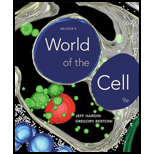
(a)
To determine: An example in which ATP is used to generate and maintain an ion gradient and a way that an ion gradient can be generated and maintained.
Introduction: The transport of sodium and potassium ions across the membrane is an active transport process, which involve the hydrolysis of adenosine triphosphate (ATP) to provide the energy. The ion gradients maintained across the plasma membranes of most cells play a significant role in
(b)
To describe: An example in which an ion gradient is used to make ATP and another use for ion gradient.
Introduction: The transport of sodium and potassium ions across the membrane is an active transport process, which involves the hydrolysis of adenosine triphosphate (ATP) to provide energy. The ion gradients maintained across the plasma membranes of most cells play a significant role in cellular energetic. Ion gradients are often either generated by the hydrolysis of ATP or used to make ATP by the phosphorylation of ADP.
(c)
To describe: Hydrolysis of ATP to drive the outward transport of sodium ions on a 2:1 and 3:1 basis.
Introduction: The transport of sodium and potassium ions across the membrane is an active transport process, which involve the hydrolysis of adenosine triphosphate (ATP) to provide the energy. The ion gradients maintained across the plasma membranes of most cells play a significant role in cellular energetic. Ion gradients are often either generated by the hydrolysis of ATP or used to make ATP by the phosphorylation of ADP.
(d)
To determine: Use of photo gradient by cell to drive ATP synthesis on a 1:1 and 1:2 basis.
Introduction: The transport of sodium and potassium ions across the membrane is an active transport process, which involve the hydrolysis of adenosine triphosphate (ATP) to provide the energy. The ion gradients maintained across the plasma membranes of most cells play a significant role in cellular energetic. Ion gradients are often either generated by the hydrolysis of ATP or used to make ATP by the phosphorylation of ADP.
Want to see the full answer?
Check out a sample textbook solution
Chapter 8 Solutions
Becker's World of the Cell (9th Edition)
- The Sentinel Cell: Nature’s Answer to Cancer?arrow_forwardMolecular Biology Question You are working to characterize a novel protein in mice. Analysis shows that high levels of the primary transcript that codes for this protein are found in tissue from the brain, muscle, liver, and pancreas. However, an antibody that recognizes the C-terminal portion of the protein indicates that the protein is present in brain, muscle, and liver, but not in the pancreas. What is the most likely explanation for this result?arrow_forwardMolecular Biology Explain/discuss how “slow stop” and “quick/fast stop” mutants wereused to identify different protein involved in DNA replication in E. coli.arrow_forward
- Molecular Biology Question A gene that codes for a protein was removed from a eukaryotic cell and inserted into a prokaryotic cell. Although the gene was successfully transcribed and translated, it produced a different protein than it produced in the eukaryotic cell. What is the most likely explanation?arrow_forwardMolecular Biology LIST three characteristics of origins of replicationarrow_forwardMolecular Biology Question Please help. Thank you For E coli DNA polymerase III, give the structure and function of the b-clamp sub-complex. Describe how the structure of this sub-complex is important for it’s function.arrow_forward
- Molecular Biology LIST three characteristics of DNA Polymerasesarrow_forwardMolecular Biology RNA polymerase core enzyme structure contains what subunits? To form holo enzyme, sigma factor is added to core. What is the name of the structure formed? Give the detailed structure of sigma factor and the function of eachdomain. Please help. Thank youarrow_forwardMolecular Biology You have a single bacterial cell whose DNA is labelled with radioactiveC14. After 5 rounds of cell division, how may cells will contain radioactive DNA? Please help. Thank youarrow_forward
- 1. Explain the structure and properties of atoms and chemical bonds (especially how they relate to DNA and proteins). Also add some pictures.arrow_forward1. In the Sentinel Cell DNA integrity is preserved through nanoscopic helicase-coordinated repair, while lipids in the membrane are fortified to resist environmental mutagens. also provide pictures for this question.arrow_forwardExplain the structure and properties of atoms and chemical bonds (especially how they relate to DNA and proteins). Also add some pictures.arrow_forward
 BiochemistryBiochemistryISBN:9781305577206Author:Reginald H. Garrett, Charles M. GrishamPublisher:Cengage Learning
BiochemistryBiochemistryISBN:9781305577206Author:Reginald H. Garrett, Charles M. GrishamPublisher:Cengage Learning BiochemistryBiochemistryISBN:9781305961135Author:Mary K. Campbell, Shawn O. Farrell, Owen M. McDougalPublisher:Cengage Learning
BiochemistryBiochemistryISBN:9781305961135Author:Mary K. Campbell, Shawn O. Farrell, Owen M. McDougalPublisher:Cengage Learning Biology: The Dynamic Science (MindTap Course List)BiologyISBN:9781305389892Author:Peter J. Russell, Paul E. Hertz, Beverly McMillanPublisher:Cengage Learning
Biology: The Dynamic Science (MindTap Course List)BiologyISBN:9781305389892Author:Peter J. Russell, Paul E. Hertz, Beverly McMillanPublisher:Cengage Learning Biology 2eBiologyISBN:9781947172517Author:Matthew Douglas, Jung Choi, Mary Ann ClarkPublisher:OpenStax
Biology 2eBiologyISBN:9781947172517Author:Matthew Douglas, Jung Choi, Mary Ann ClarkPublisher:OpenStax




